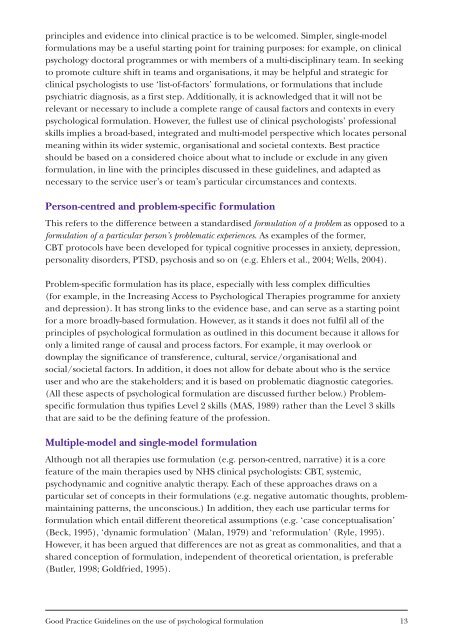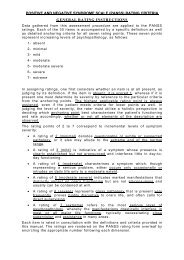DCP-Guidelines-for-Formulation
DCP-Guidelines-for-Formulation
DCP-Guidelines-for-Formulation
Create successful ePaper yourself
Turn your PDF publications into a flip-book with our unique Google optimized e-Paper software.
principles and evidence into clinical practice is to be welcomed. Simpler, single-model<strong>for</strong>mulations may be a useful starting point <strong>for</strong> training purposes: <strong>for</strong> example, on clinicalpsychology doctoral programmes or with members of a multi-disciplinary team. In seekingto promote culture shift in teams and organisations, it may be helpful and strategic <strong>for</strong>clinical psychologists to use ‘list-of-factors’ <strong>for</strong>mulations, or <strong>for</strong>mulations that includepsychiatric diagnosis, as a first step. Additionally, it is acknowledged that it will not berelevant or necessary to include a complete range of causal factors and contexts in everypsychological <strong>for</strong>mulation. However, the fullest use of clinical psychologists’ professionalskills implies a broad-based, integrated and multi-model perspective which locates personalmeaning within its wider systemic, organisational and societal contexts. Best practiceshould be based on a considered choice about what to include or exclude in any given<strong>for</strong>mulation, in line with the principles discussed in these guidelines, and adapted asnecessary to the service user’s or team’s particular circumstances and contexts.Person-centred and problem-specific <strong>for</strong>mulationThis refers to the difference between a standardised <strong>for</strong>mulation of a problem as opposed to a<strong>for</strong>mulation of a particular person’s problematic experiences. As examples of the <strong>for</strong>mer,CBT protocols have been developed <strong>for</strong> typical cognitive processes in anxiety, depression,personality disorders, PTSD, psychosis and so on (e.g. Ehlers et al., 2004; Wells, 2004).Problem-specific <strong>for</strong>mulation has its place, especially with less complex difficulties(<strong>for</strong> example, in the Increasing Access to Psychological Therapies programme <strong>for</strong> anxietyand depression). It has strong links to the evidence base, and can serve as a starting point<strong>for</strong> a more broadly-based <strong>for</strong>mulation. However, as it stands it does not fulfil all of theprinciples of psychological <strong>for</strong>mulation as outlined in this document because it allows <strong>for</strong>only a limited range of causal and process factors. For example, it may overlook ordownplay the significance of transference, cultural, service/organisational andsocial/societal factors. In addition, it does not allow <strong>for</strong> debate about who is the serviceuser and who are the stakeholders; and it is based on problematic diagnostic categories.(All these aspects of psychological <strong>for</strong>mulation are discussed further below.) Problemspecific<strong>for</strong>mulation thus typifies Level 2 skills (MAS, 1989) rather than the Level 3 skillsthat are said to be the defining feature of the profession.Multiple-model and single-model <strong>for</strong>mulationAlthough not all therapies use <strong>for</strong>mulation (e.g. person-centred, narrative) it is a corefeature of the main therapies used by NHS clinical psychologists: CBT, systemic,psychodynamic and cognitive analytic therapy. Each of these approaches draws on aparticular set of concepts in their <strong>for</strong>mulations (e.g. negative automatic thoughts, problemmaintainingpatterns, the unconscious.) In addition, they each use particular terms <strong>for</strong><strong>for</strong>mulation which entail different theoretical assumptions (e.g. ‘case conceptualisation’(Beck, 1995), ‘dynamic <strong>for</strong>mulation’ (Malan, 1979) and ‘re<strong>for</strong>mulation’ (Ryle, 1995).However, it has been argued that differences are not as great as commonalities, and that ashared conception of <strong>for</strong>mulation, independent of theoretical orientation, is preferable(Butler, 1998; Goldfried, 1995).Good Practice <strong>Guidelines</strong> on the use of psychological <strong>for</strong>mulation 13



